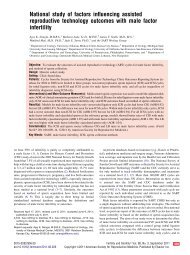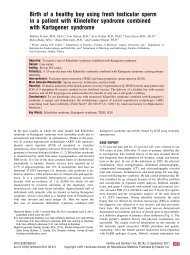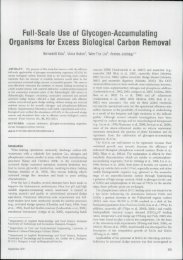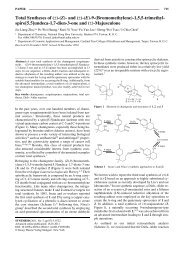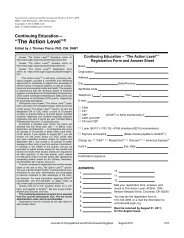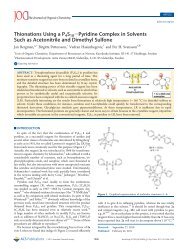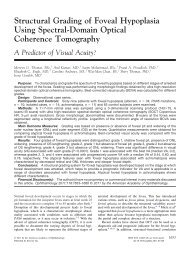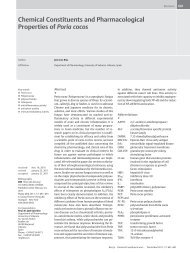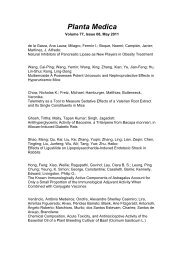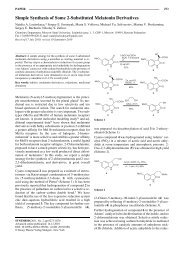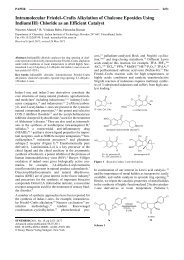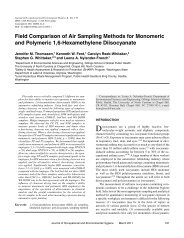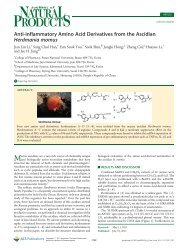Palladium- and Copper-Catalyzed Aryl Halide Amination ...
Palladium- and Copper-Catalyzed Aryl Halide Amination ...
Palladium- and Copper-Catalyzed Aryl Halide Amination ...
You also want an ePaper? Increase the reach of your titles
YUMPU automatically turns print PDFs into web optimized ePapers that Google loves.
REVIEW <strong>Palladium</strong>- <strong>and</strong> <strong>Copper</strong>-<strong>Catalyzed</strong> Heterocycle Synthesis 15<br />
MeO<br />
Scheme 46<br />
lysts. 101 In both cases the phenazine ring system was isolated<br />
directly from the amination reactions.<br />
2.11 Cinnolines<br />
An intermolecular copper-catalyzed aryl amination was<br />
used by Nishida <strong>and</strong> co-workers to access cinnoline derivatives.<br />
In the example shown in Scheme 47, hydrazonesubstituted<br />
aryl iodide 107 was converted into N-acyldihydrocinnoline<br />
108 using a copper(I) iodide/diamine<br />
catalyst. 102 The use of superstoichiometric amounts of catalyst<br />
led to mixtures of N-acyl product 108 together with<br />
smaller amounts (up to 40%) of the aromatic cinnoline being<br />
obtained. Cyclization of hydrazines derived from hydrazone<br />
107 allowed access to 1-aminoindoles.<br />
I<br />
NH2<br />
107<br />
Scheme 47<br />
H<br />
N<br />
Br<br />
104<br />
OTBS<br />
CO2t-Bu HN<br />
Ac<br />
N<br />
3 Carbon–Oxygen Bond Formation<br />
Initially, the development of catalytic carbon–oxygen<br />
bond-forming processes using aryl halide substrates<br />
lagged behind the corresponding carbon–nitrogen forming<br />
reactions; however, efficient methods, using both palladium<br />
<strong>and</strong> copper catalysts, are now well established.<br />
3.1 Benzofurans<br />
Pd 2(dba) 3 (3 mol%)<br />
JohnPhos (6 mol%)<br />
NaOt-Bu<br />
toluene, 100 °C MeO<br />
P(t-Bu)2<br />
JohnPhos (106)<br />
CuI (10 mol%)<br />
25 (10 mol%)<br />
Cs 2CO 3<br />
DMSO, r.t.<br />
N N<br />
Ac<br />
108, 89%<br />
Few examples of benzofuran syntheses that proceed via a<br />
metal-catalyzed intermolecular (aryl)carbon–oxygen<br />
bond-forming reaction exist. In one example, Buchwald<br />
<strong>and</strong> co-workers were able to apply their palladium-catalyzed<br />
phenol synthesis to the preparation of benzofurans.<br />
103 The chemistry was based on the use of<br />
potassium hydroxide as a nucleophile in the palladiumcatalyzed<br />
hydroxylation of aryl halides to provide phenols.<br />
When applied to benzofuran synthesis, o-chloroarylalkyne<br />
substrates reacted with potassium hydroxide in the<br />
presence of t-Bu-XPhos as catalyst, to give o-hydroxyalkynylarenes,<br />
which, as previously shown, 104 undergo<br />
N<br />
N<br />
105, 76%<br />
OTBS<br />
CO2t-Bu cyclization to the required benzofurans (109 → 110,<br />
Scheme 48). You’s research group went on to develop a<br />
copper-catalyzed version of the hydroxylation reaction<br />
<strong>and</strong> also demonstrated its use in benzofuran synthesis, in<br />
this case from an o-iodoarylalkyne to generate benzofuran<br />
112. 105<br />
F 3C<br />
Cl<br />
109<br />
Scheme 48<br />
A greater number of research groups have utilized intramolecular<br />
carbon–oxygen bond formation as the key<br />
step in benzofuran syntheses. In 2004 Willis et al. demonstrated<br />
the use of a-(o-haloaryl) ketones as precursors to<br />
the required oxygen heterocycles via an enolization/palladium-catalyzed<br />
intramolecular O-arylation reaction, with<br />
a Pd 2(dba) 3/DPEPhos catalyst system proving optimum<br />
for the process (Scheme 49). 106 The starting ketones were<br />
themselves formed by a palladium-catalyzed ketone arylation;<br />
however, attempts to achieve a one-pot combination<br />
of these processes was not straightforward, <strong>and</strong> after<br />
optimization only a single high-yielding example of the<br />
cascade could be achieved. Kotschy <strong>and</strong> co-workers<br />
showed that the same cyclization of o-bromobenzyl ketones,<br />
which they accessed from aromatic aldehydes <strong>and</strong><br />
2-bromobenzyl bromide using dithiane chemistry, is possible<br />
using a palladium–NHC catalyst system. 107<br />
O<br />
Scheme 49<br />
Cl<br />
I<br />
O<br />
Br<br />
Me<br />
86%<br />
(NaOt-Bu)<br />
Ph<br />
S<br />
KOH<br />
F3C<br />
Pd2(dba) 3 (2 mol%)<br />
t-BuXPhos (8 mol%)<br />
H2O, dioxane<br />
100 °C<br />
KOH<br />
Ph CuI (10 mol%)<br />
1,10-phenathroline<br />
(20 mol%)<br />
H 2O, DMSO<br />
100 °C<br />
t-Bu2P i-Pr<br />
i-Pr<br />
t-BuXPhos (111)<br />
Cs2CO3<br />
toluene, 100 °C<br />
Synthesis 2011, No. 1, 1–22 © Thieme Stuttgart · New York<br />
Cl<br />
i-Pr<br />
Pd 2(dba) 3 (2.5 mol%)<br />
DPEPhos (22) (6 mol%)<br />
N<br />
O<br />
86%<br />
(NaOt-Bu)<br />
(chloro substrate)<br />
F<br />
O<br />
110, 87%<br />
O<br />
112, 86%<br />
O<br />
95%<br />
O<br />
74%<br />
(NaOt-Bu)<br />
Ph<br />
S



